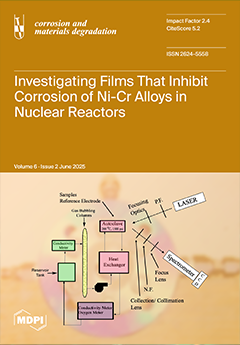This study demonstrates that effervescent denture cleansers can influence the electrochemical behavior of cobalt–chromium (Co-Cr) alloys, with a particular focus on their corrosion resistance. The findings underscore the importance for dental professionals of selecting cleansers compatible with Co-Cr prostheses to minimize material degradation and enhance clinical durability. Corrosion resistance was evaluated using open-circuit potential (OCP), corrosion current density (i
corr), and passivation current density (i
pass). Surface morphology and elemental composition were analyzed through scanning electron microscopy (SEM) and energy-dispersive X-ray spectroscopy (EDS). Forty specimens (
n = 5 per group) were individually immersed in one of ten test solutions: distilled water (DW), artificial saliva (AS), and eight commercial denture cleansers—Polident 3 minutes™ (P3M), Steradent™ (St), Polident for Partials™ (PP), Efferdent™ (Ef), Corega Tabs™ (CT), NitrAdine™ (Ni), Fixodent™ (Fi), and Kukident™ (Ku). Each specimen was exposed a single solution to avoid cross-contamination. Results showed St, Ef, and Ku had higher OCP values than DW and Ni (
p < 0.05), indicating better corrosion resistance. AS exhibited lower OCP values compared to St (
p = 0.034), Ku (
p = 0.023), and P3M (
p = 0.050). DW had higher i
corr than PP (
p = 0.030), CT (
p = 0.005), and P3M (
p = 0.003). For i
pass, DW had lower values than Ef (
p = 0.025) and Ku (
p = 0.016). SEM and EDS revealed no significant surface alterations. Understanding the underlying corrosion mechanisms in different solutions provides valuable insights into optimizing material performance and ensuring durability in clinical applications. The corrosion resistance of Co-Cr depends on the stability of the passive oxide layer, which can be degraded by chloride ions, reinforced by sulfate ions, and influenced by active ingredients in denture cleansers. Overall, the Co-Cr alloy demonstrated acceptable corrosion resistance, underscoring the importance of selecting suitable cleansers for prosthesis longevity.
Full article





